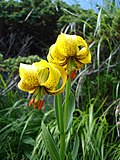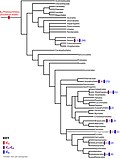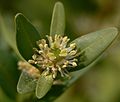The APG II system (Angiosperm Phylogeny Group II system) of plant classification is the second, now obsolete, version of a modern, mostly molecular-based...
7 KB (650 words) - 01:27, 20 October 2022
was replaced by the improved APG II in 2003, APG III system in 2009 and APG IV system in 2016. The original APG system is unusual in being based, not...
20 KB (1,426 words) - 19:08, 1 June 2024
The APG III system of flowering plant classification is the third version of a modern, mostly molecular-based, system of plant taxonomy being developed...
47 KB (3,194 words) - 04:17, 8 April 2024
The APG IV system of flowering plant classification is the fourth version of a modern, mostly molecular-based, system of plant taxonomy for flowering...
40 KB (2,558 words) - 13:57, 8 April 2024
The AN/APG-85 is an active electronically scanned array (AESA) radar system designed by Northrop Grumman for the Lockheed Martin F-35 Lightning II. The...
3 KB (240 words) - 07:01, 15 May 2024
(formerly Westinghouse Electronic Systems) for the Lockheed Martin F-35 Lightning II. The Joint Strike Fighter AN/APG-81 AESA radar is a result of the...
6 KB (648 words) - 18:33, 28 March 2024
Tiliaceae (section APG II system)
(/ˌtɪliˈeɪsii/) is a family of flowering plants. It is not a part of the APG, APG II and APG III classifications, being sunk in Malvaceae mostly as the subfamilies...
7 KB (751 words) - 00:33, 5 January 2024
Liliopsida (section Liliopsida in the Takhtajan system)
name Liliidae (a name in the rank of subclass). Modern systems, such as the APG and APG II systems refer to this group by the name monocots (a name for...
7 KB (675 words) - 22:54, 1 October 2023
revisions have been published, in 2003 (APG II), in 2009 (APG III) and in 2016 (APG IV), each superseding the previous system. Thirteen researchers have been...
33 KB (3,527 words) - 05:32, 8 April 2024
Liliidae (section Liliidae in APG II system)
In the Dahlgren system and the Thorne system (1992) this is an important name: this subclass comprises the monocotyledons (in APG II these are the monocots)...
3 KB (245 words) - 21:37, 17 June 2022
circumscription: order Batales family Gyrostemonaceae family Bataceae The APG II system, used here, includes all the plants involved in the (expanded) order...
882 bytes (74 words) - 13:48, 3 June 2024
of the family is the yam (some species of Dioscorea). The APG system (1998) and APG II system (2003) both place it in the order Dioscoreales, in the clade...
7 KB (482 words) - 04:52, 8 April 2024
Alismatidae (section APG II system)
these are aquatic or semiaquatic plants (see Alismatidae info). The APG II system does not use formal botanical names above the rank of order; it assigns...
2 KB (195 words) - 01:33, 23 December 2022
Commelinids (section APG system)
containing ferulic acid. The commelinids are the only clade that the APG IV system has informally named within the monocots. The remaining monocots are...
12 KB (837 words) - 03:56, 14 April 2024
Arecidae (section APG II system)
Pandanaceae order Arales family Acoraceae family Araceae family Lemnaceae The APG II system does not use formal botanical names above the rank of order; it assigns...
2 KB (180 words) - 18:02, 29 March 2021
Caryophyllales (section APG II)
Petiveriaceae were added in APG IV. As circumscribed by the APG III system (2009), this order includes the same families as the APG II system (see below) plus the...
12 KB (1,032 words) - 03:35, 8 April 2024
plant taxonomy. In the APG II system (2003) the plants involved are mostly placed in the order Malpighiales. A well known system that did recognize the...
1 KB (124 words) - 17:37, 5 December 2022
Simaroubaceae The APG II system of 2003 allowed the optional segregation of families now included in the Nitrariaceae. In the classification system of Dahlgren...
5 KB (407 words) - 02:55, 8 April 2024
separate family in more recent treatments such as the APG II system (2003). The APG II system assigns the Strelitziaceae to the order Zingiberales in...
5 KB (331 words) - 03:46, 8 April 2024
flowering plants, included within the asterid group of dicotyledons. In the APG III system of 2009, the order includes only two families, Adoxaceae and a broadly...
3 KB (263 words) - 04:40, 8 April 2024
flowering plants. The name is newly accepted in the APG III system of plant taxonomy. APG II system, of 2003, mentions the possibility of recognizing the...
2 KB (193 words) - 16:17, 25 April 2024
modern treatment, however, the APG III system of 2009 (unchanged from the 2003 APG II system and the 1998 APG system), places the family in the order...
6 KB (505 words) - 09:34, 18 May 2024
family Joinvilleaceae family Restionaceae family Centrolepidaceae The APG II system (2003) assigns the plants involved to the order Poales. Linder, H. P...
1 KB (107 words) - 07:56, 10 March 2024
potentially containing one family, Dilleniaceae. The APG III system of 2009, like the earlier APG II system of 2003, left the Dilleniaceae unplaced as to order...
2 KB (170 words) - 03:02, 8 April 2024
cultivars. Cannas are not true lilies, but have been assigned by the APG II system of 2003 to the order Zingiberales in the monocot clade Commelinids,...
38 KB (3,963 words) - 01:34, 4 May 2024
Zingiberidae (section APG II system)
of: subclass Zingiberidae order Zingiberales order Bromeliales The APG II system does not use formal botanical names above the rank of order. The plants...
1 KB (127 words) - 03:49, 29 January 2023
Magnoliales (section APG system)
hundred species including nutmeg) The APG system (1998), APG II system (2003), APG III system (2009), and APG IV system (2016) place this order in the clade...
7 KB (574 words) - 05:28, 8 April 2024
recognized in the APG II system, of 2003, which places the plants involved in the order Poales. Some examples are: The Cronquist system of 1981 placed this...
1 KB (136 words) - 18:47, 13 October 2023
a slight change from the APG system of 1998, which firmly recognised both families as separate. In both APG and APG II, the family Buxaceae is unplaced...
4 KB (375 words) - 17:30, 26 October 2023
flowering plants. The APG IV system of 2016 (unchanged from the APG III system of 2009, the APG II system of 2003 and the APG system of 1998) places the...
4 KB (360 words) - 03:06, 8 April 2024























